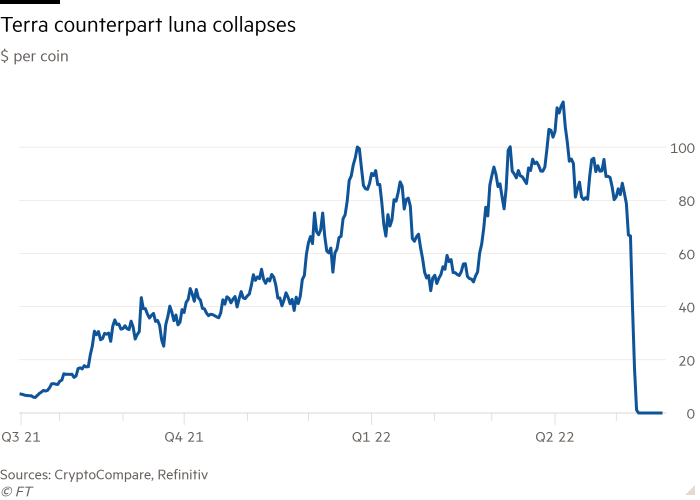Binance promoted terraUSD as a “safe” investment just weeks before the stablecoin and its counterpart luna collapsed in a $40bn wipeout that shook the crypto industry.
The world’s biggest crypto exchange advertised on April 6 an investment scheme in which clients lend out their terra to earn a yield of almost 20 per cent as a “safe and happy” opportunity, according to a message Binance sent on its official channel on the Telegram messaging app.
Terra and luna, a set of linked digital tokens, were popular with crypto traders seeking to earn high returns through lending programmes known as “staking”, but lost nearly all of their value earlier this month in one of the crypto industry’s biggest-ever crashes.
Binance is one of the most influential players in the crypto sector, processing around $1tn of trades a month and offering a wide range of financial products through its website. Its promotion of terra as a safe investment highlights the central role crypto exchanges play in choosing which digital tokens are made easily accessible to mainstream traders.
Advertising of crypto investments has emerged as a concern for regulators in several countries, who worry about promotions that downplay the risk of cryptocurrencies or encourage small investors to put their money into complex digital asset products that have few legal protections.
The UK government plans to tighten the standards for crypto ads. Singapore earlier this year banned almost all public transport and social media influencer ads for crypto, while Spain said it will require influencers to notify regulators in advance about crypto posts.
Binance’s Telegram message, which was viewed 117,000 times on an app widely used by crypto enthusiasts, provided no disclosures, although a website the advert linked to noted that “cryptocurrency trading is subject to high market risk”. Binance had also in 2021 promoted a luna staking scheme as a “safe” investment.
Binance told the Financial Times it is now “reviewing how campaigns for projects, such as Luna, are evaluated prior to them being advertised”.
Terra is a so-called stablecoin that attempts to mirror the value of $1 through a relationship with cryptocurrency luna that is set by algorithms. If terra falls below $1, traders are incentivised to purchase the stablecoin, and then redeem it for $1 worth of newly minted luna tokens. They pocket the difference in price as profit. However, the relationship broke down earlier this month, causing the values of both coins to collapse to near zero.
The fall of luna hit many retail traders with severe losses and ricocheted through the crypto market. Bitcoin, the world’s most valuable crypto token, fell to its lowest level since late 2020 as the luna incident added to broader pressures across the digital asset market.
Binance chief executive Changpeng Zhao acknowledged in a blog post on Friday that “it’s now obvious that the whole thing was built on a self-perpetuating, shallow concept”.
He added: “While terra did have an ecosystem with some use cases, the speed of growth of the ecosystem did not match the speed of the incentives used to attract new users.”

Zhao said at the Financial Times Digital Assets Summit in April that while the exchange performs “due diligence” on the coins on its platforms, the most important metric for its decision-making is a token’s popularity. “If something is used by a large number of users . . . it has value,” he commented.
The group, which has no fixed headquarters, was censured last year by the UK financial regulator, which warned that the group’s “complex and high-risk financial products” posed “a significant risk to consumers”.
However, it has recently made headway in garnering regulatory approvals elsewhere. Binance is planning to make France “at least” a regional headquarters after regulators earlier this month gave its local subsidiary approval to act as a registered digital assets service provider — the first EU country to do so. Binance has also received similar approvals in Dubai and Bahrain.

Click here to visit Digital Assets dashboard





